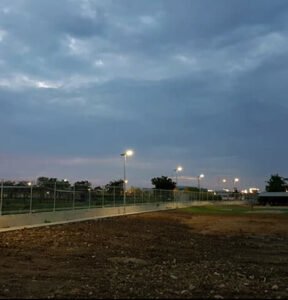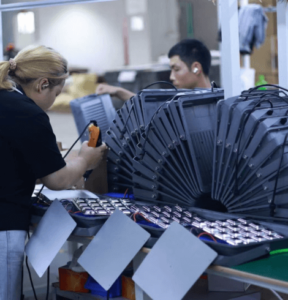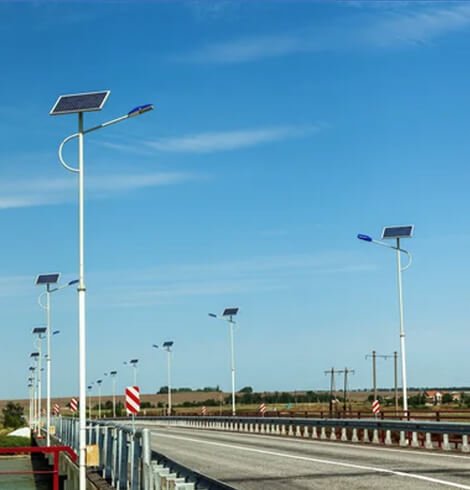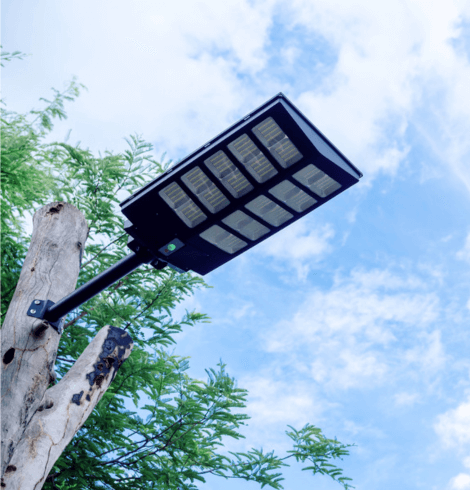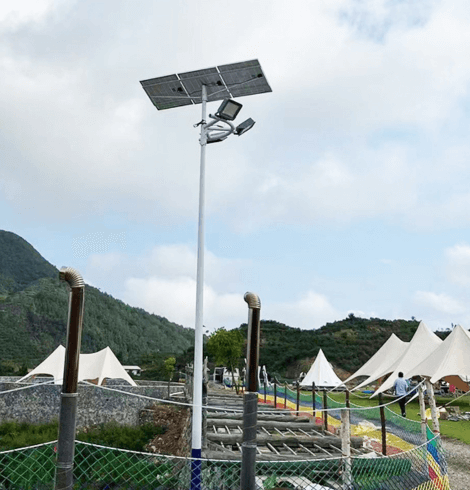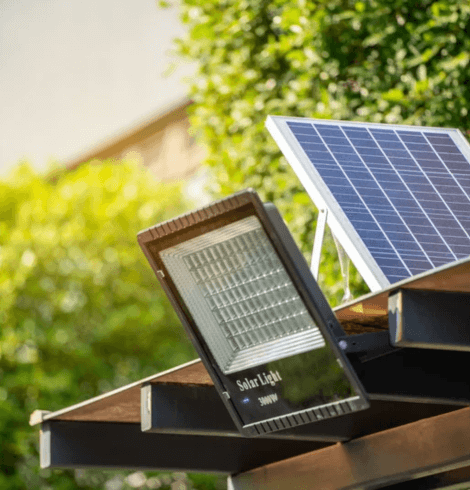The most commonly used batteries in solar street lights are Lithium Iron Phosphate (LiFePO₄), Lithium-Ion (Li-ion), Gel Lead-Acid, and Flooded Lead-Acid batteries. Among them, LiFePO₄ is widely considered the best option for long-term, low-maintenance use due to its high safety, long lifespan (8–12 years), and excellent performance in extreme weather.
Table of Contents
ToggleIntroduction
When the sun goes down, solar street lights switch on—and behind that magic is one crucial component: the battery.
Solar street lights don’t just rely on panels to harvest sunlight. They depend on batteries to store that energy and release it when it’s dark. And the type of battery used? That makes a world of difference in how long the lights last, how bright they shine, and how much upkeep they need.
So, which batteries are most commonly used in solar lighting? What are their strengths and trade-offs? And how do you choose the right one for your project?
Let’s break it all down—simply, clearly, and without jargon.
Types of Batteries Used in Solar Street Lights (Compared)
Before we dive into comparisons, it helps to know what’s out there.
Solar street lights typically rely on four types of batteries. Each one has different strengths when it comes to cost, lifespan, safety, and efficiency. Let’s go through them one by one, starting with the most modern option.
Lithium Iron Phosphate (LiFePO₄) Battery
Think of LiFePO₄ as the gold standard in solar lighting batteries. It’s reliable, long-lasting, and very safe—even under tough weather conditions.

These batteries can run for 8 to 10 years, sometimes even longer. They’re especially great for places with extreme heat or cold, where other batteries might struggle or degrade.
And here’s the best part: LiFePO₄ is one of the safest battery chemistries available. Unlike some other lithium batteries, it doesn’t catch fire or explode under stress. That makes it a top pick for outdoor use.
They charge quickly, handle deep discharges with ease, and require little to no maintenance. In fact, once installed, many LiFePO₄-powered lights can run for years with no hands-on attention.
Lithium-Ion (Li-ion) Battery
Next up, we have the more familiar lithium-ion battery—the same kind found in phones and laptops.

Li-ion batteries are efficient, lightweight, and fast-charging. They can reach 80% charge in just a couple of hours and typically last between 5 to 8 years. That’s a big leap compared to older battery types.
However, there’s a trade-off. Li-ion batteries can be more sensitive to overheating or overcharging, so they always need to be paired with a smart Battery Management System (BMS). With proper care, though, they’re highly dependable.
In many mid- to high-end solar lighting projects, Li-ion batteries offer the perfect balance of performance and cost.
Lead-Acid Battery (Flooded & AGM)
Now let’s go old-school.
Lead-acid batteries have been around for decades. They’re bulky, heavy, and slower to charge—but they’re also incredibly budget-friendly.

Because of their low upfront cost, lead-acid batteries are often used in small or short-term projects. However, they usually last only 2 to 4 years, and their performance drops off quickly with deep discharges.
Flooded types need regular maintenance—like topping off water levels—while AGM variants are sealed and require less attention. But compared to lithium options, even the best lead-acid setups involve more hands-on work.
Still, for temporary setups or areas with a very limited budget, they remain a practical option.
Gel Lead-Acid Battery
Think of gel batteries as the upgraded cousin of traditional lead-acid.

They use a gelled electrolyte, which means no spills, minimal gas emissions, and no need for regular maintenance. That makes them safer and more reliable than standard flooded batteries—especially in remote or hard-to-access locations.
They also handle extreme temperatures better and support deeper discharges, which means slightly more usable capacity per charge. On average, you’ll get around 4 to 6 years of service life.
They’re more expensive than traditional lead-acid, but still cheaper than lithium batteries. That puts gel batteries in a sweet spot for projects that need decent performance without the high cost of lithium.
How to Choose the Right Battery for Your Solar Street Light
So now that we know the main types, the big question is: which one should you choose?
There’s no one-size-fits-all answer—it depends on your project’s needs and priorities.
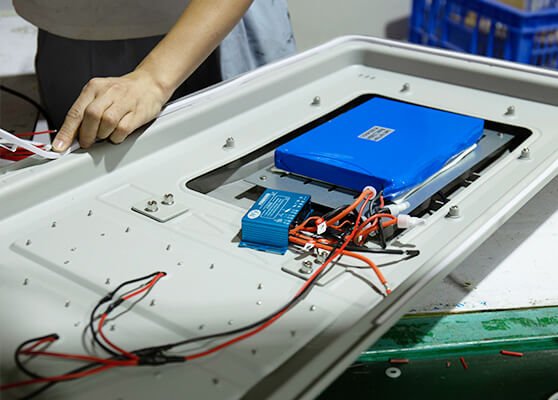
If you’re working with a tight budget and short-term expectations, lead-acid (or gel) might do the job. But if you’re thinking long-term—especially for remote areas or critical lighting—lithium batteries are almost always the better investment.
Need something ultra-stable and reliable in harsh climates? Go with LiFePO₄.
Want high energy density in a compact space? Lithium-ion works great, as long as there’s a solid battery management system.
Battery Buying Guide: What to Look for in Solar Street Light Batteries
Still not sure which battery fits your needs? Let’s make it easier by breaking down the most important decision factors:
- Cost: Upfront cost matters, but so does long-term value. Lead-acid is cheaper at first, but lithium lasts longer.
- Lifespan: How often do you want to replace the battery? Lithium batteries can last more than twice as long.
- Maintenance: Do you have the resources to check the batteries regularly? If not, maintenance-free options like LiFePO₄ or gel are best.
- Efficiency: Lithium batteries convert more solar energy into usable light with less waste.
- Environment: Lead batteries contain toxic materials and must be recycled carefully. LiFePO₄ is safer and more eco-friendly.
Once you weigh these factors, your choice becomes much clearer.
| Battery Type | Lifespan | Cost (Upfront) | Maintenance | Performance in Extreme Weather | Best For |
|---|---|---|---|---|---|
| LiFePO₄ | 8–12 years (3,000–5,000 cycles) | High | None | Excellent (wide range) | Long-term, high-performance projects |
| Li-Ion | 3–5 years (500–1,000 cycles) | Moderate | None | Good (moderate range) | Compact installations, urban projects |
| Lead-Acid (AGM/Gel) | 3–5 years (300–500 cycles) | Low | Low (sealed units) | Poor to moderate (heat/cold) | Budget-conscious, short-term setups |
| Flooded Lead-Acid | 2–4 years (300–400 cycles) | Very Low | High (watering, venting) | Poor (heat-sensitive, needs shelter) | Low-cost trials, accessible locations |
Solar Battery Maintenance Tips to Extend Lifespan
Whichever battery you choose, one thing’s for sure: proper maintenance can stretch its lifespan significantly.

Here’s how to get the most out of your solar street light battery:
Keep It Clean: Dust and debris on or around the battery can cause overheating or connection issues. A quick wipe-down now and then helps.
Avoid Temperature Extremes: Most batteries don’t like being too hot or too cold. If possible, install them in a shaded, ventilated area or within an insulated enclosure.
Watch for Damage: Check for cracks, corrosion, or signs of wear. Catching small issues early can prevent bigger problems later.
Use the Right Charger: Especially for lithium batteries—using the wrong charger can shorten their life or even damage them. Always follow manufacturer guidelines.
And remember: lithium and gel batteries are virtually maintenance-free—but it never hurts to check in on them occasionally, especially during routine light pole maintenance.
Final Thoughts: Which Solar Street Light Battery is Best?
So, what kind of batteries are used in solar street lights?
In short: it depends. From old-school lead-acid to modern lithium packs, each type has a place depending on your budget, location, and project goals.
Lead-acid remains useful for low-cost, short-term needs. Gel offers a bit more stability without breaking the bank. Lithium-ion is fast, efficient, and compact. And LiFePO₄? That’s the future—ultra-safe, long-lasting, and maintenance-free.
As battery tech evolves, we’re seeing even smarter options on the horizon—like solid-state batteries and AI-managed charging. These innovations promise longer life, higher efficiency, and lights that just keep shining, night after night.
In the end, a good solar street light is only as good as its battery. Choose wisely, and you’ll get years of reliable, clean lighting with minimal fuss.
FAQ (Top 5 Questions Answered)
1. How long do solar street light batteries last?
It depends on the battery type. Lead-acid batteries usually last 2–4 years, while lithium-ion lasts around 5–8 years. LiFePO₄ can go 8–10 years or even longer.
2. Can I use any battery for solar street lights?
Not exactly. You need deep-cycle batteries designed for regular charging and discharging. Regular car batteries won’t work. Stick with lead-acid, gel, or lithium options made for solar systems.
3. Are lithium batteries safe for solar street lights?
Yes—especially LiFePO₄, which is known for its stability. Just make sure the battery includes a good Battery Management System (BMS) to handle charging and protection.
4. Why are lithium batteries better than lead-acid for solar lights?
Lithium batteries last longer, charge faster, and store energy more efficiently. They’re also lighter and require no maintenance, making them ideal for long-term use.
5. Can I upgrade from lead-acid to lithium?
Yes, but check the system’s voltage and charging setup first. Lithium batteries often need different charge controllers or protective features. It’s a smart upgrade—but do it safely.



